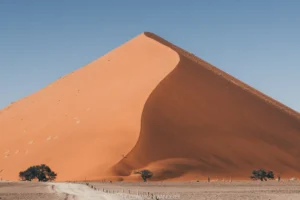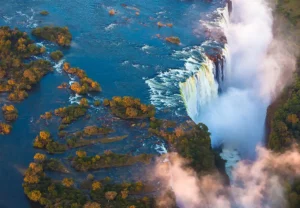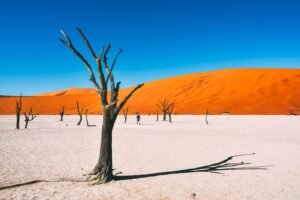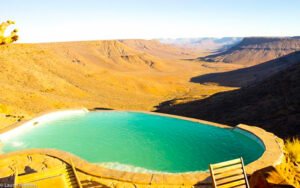



Namibia, a land of extremes, paints its canvas in scorching sun, rolling dunes, rocky outcrops, and rare creatures that cling to life in harsh terrain. For travellers seeking adventure, wonder, and learning, Namibia is one of the world’s premier stage settings for desert landscapes & unique wildlife. From sand seas as old as time to animals adapted to near-impossible conditions, this country invites you not just to observe, but to reflect on survival, time, and the fragility of ecosystems. In this article we explore the best places to visit in Namibia in 2025, focusing on its desert landscapes & unique wildlife, providing information useful for travel, research, and deep appreciation.
Understanding Namibia: Geography, Climate, and Ecology
Before delving into specific destinations, to fully appreciate the desert landscapes & unique wildlife, one must grasp the underlying geography, climate zones, and ecological features of Namibia.
-
Namibia sits in southern Africa, bordered by the Atlantic Ocean to the west, Angola to the north, Zambia and Botswana to the northeast and east, and South Africa to the south.
-
It is home to the Namib Desert (along the Atlantic Coast)—often considered the world’s oldest desert—whose dune fields, gravel plains, fog deserts, and coastal cliffs create dramatic desert landscapes. natural-destinations.com+2Wikipedia+2
-
Further inland lie the semi-arid Kalahari, mountain ranges like the Naukluft, and riparian zones in the northeast such as the Kavango and Zambezi regions. These give rise to wildlife diversity, especially where water exists even intermittently.
-
Climate is extreme and variable: scorching days, cold nights, sometimes frost in highlands; rainfall is very low in deserts, higher in the northeast; fog from the cold Atlantic influences life along the coast. These conditions force both flora and fauna into extraordinary adaptations.
With that context, the following are some of the must-see places in Namibia for experiencing desert landscapes & unique wildlife in full magnitude in 2025.
Major Destinations to Experience Desert Landscapes & Unique Wildlife
Here are the top destinations, each offering a different facet of Namibia’s extraordinary deserts and wildlife. Each section includes what to see, how to get there, when best to visit, and special features for study or photography.
1. Namib-Naukluft National Park & Sossusvlei Region
What & Where
At the heart of Namibia’s desert magic lies Namib-Naukluft National Park, one of Africa’s largest protected areas. Within it, the region of Sossusvlei, Deadvlei, and Sesriem are among the most iconic places to immerse in desert landscapes & unique wildlife. Wikipedia+2Unseen Namibia+2
Highlights
-
Dunes: Towering red dunes, some among the tallest in the world. Dune 45 and “Big Daddy” are well-known for sunrise climbs. Unseen Namibia+1
-
Deadvlei: A white clay pan dotted with dead, charred camel thorn trees, set against vivid dunes and a deep blue sky. The contrast and textures make for hauntingly beautiful photos—and offers a lesson in geological and climatic history. Unseen Namibia+1
-
Sesriem Canyon: A narrow canyon carved by the ephemeral Tsauchab River, found near the park’s entry. When rains come, water flows; otherwise, the canyon offers shade, geological strata, and wildlife gathering at small water pools. Wikipedia+1
Wildlife & Flora
Even in these stark settings life finds ways. Among the wildlife you may see:
-
Desert-adapted antelope such as gemsbok (oryx).
-
Smaller mammals (e.g. bat-eared fox, ground squirrels).
-
Reptiles and insects adapted to heat and scarce water.
-
Birdlife including raptors and smaller birds that survive on insects or sparse vegetation.
Flora includes the resilient welwitschia mirabilis, euphorbias, acacias in sheltered areas, adapted succulents. The contrast of vivid red dunes, pale clay, blackened dead trees, and brilliant skies make this region a field study in geology, ecology, and climatology.
Best Time to Visit
-
Early morning for dunes (sunrise) to get cooler temperatures and best lighting.
-
Dry season (roughly May to October) for clearer skies, less heat, more predictable conditions.
-
For cooler yet still dry times, May-June are great; nights can be cold.
2. Skeleton Coast & Sandwich Harbour
What & Where
The Skeleton Coast runs along the Atlantic shore in northern and north-western Namibia. It is named for shipwrecks, whale and seal bones, and a rugged meeting of sea, sand, and mist. Sandwich Harbour, south of Walvis Bay, is part of this coastal desert mosaic. desertafricasafaris.com+2Unseen Namibia+2
Highlights
-
Shipwrecks and Ghost Towns: e.g. the wrecks at the high tide line, rusting hulks half swallowed by sand.
-
Coastal Desert: windblown dunes meeting the cold Atlantic, frequent fogs (from the Benguela current) that create mist deserts – where moisture from fog supports lichens, seals, coastal scavengers.
-
Sand dunes and lagoons at Sandwich Harbour: dramatic dunes dropping into the sea; lagoon ecosystems fed by fog and occasional runoff that attract birdlife.
Wildlife
-
Seals along the shore.
-
Coastal scavengers (birds, small mammals) that exploit both sea and desert.
-
Fog-dependent organisms: plants, lichens.
-
Species that move between land and marine food chains, especially birds.
Best Time to Visit
-
Fog and mist more persistent in cooler months along the coast, though always variable.
-
Morning for better views; midday fog can obscure visibility.
-
Dry season to avoid heavy rains in northern parts.
3. Damaraland & Kaokoland (Including Hoanib, Kunene Region)
What & Where
Damaraland lies between Etosha and the coast. Kaokoland (northwestern Namibia, especially the Kunene region) is remoter, more rugged, inhabited by Himba communities, and home to some of the most impressive desert wildlife adaptations. Dinogo.com+2Kenlink Tours+2
Highlights
-
Rock formations: Brandberg (largest mountain in Namibia), Twyfelfontein (ancient rock engravings), the Petrified Forest. Dinogo.com+1
-
Dry riverbeds (ephemeral rivers), granite inselbergs, rugged terrain.
-
Cultural interaction: traditional communities like the Himba, whose lifestyles are deeply adapted to arid conditions.
Wildlife
-
Desert-adapted elephants that walk great distances for water and forage. Namibia Today+1
-
Large oryx / gemsbok, springbok, lions that roam dry terrain.
-
Smaller mammals, reptiles, birds adapted to the rough mountainous and semi-arid environments.
Best Time to Visit
-
Dry season to access remote roads (June to October).
-
Cooler mornings and evenings for wildlife activity.
-
Rainy season brings temporary water, increased vegetation, but access is harder and some areas might be closed.
4. Etosha National Park
What & Where
Etosha is one of Namibia’s premier wildlife reserves, centred on the vast salt pan of Etosha (“Great White Place”). It lies in northern Namibia. While not a desert in the strict sense of vast dunes, Etosha is semi-arid and lies in a zone where droughts are frequent; wildlife congregates at waterholes — a dramatic theatre of survival in dry landscapes. Kenlink Tours+1
Highlights
-
The Etosha Pan: in dry times a blinding white salt flat; in wetter periods rumours of shallow water, attracting flamingos, birds.
-
Numerous waterholes where large mammals (elephants, rhinos, giraffes, zebras, antelopes) congregate; predators follow.
-
Excellent birdwatching — diverse species especially near flood or water sources.
Wildlife
-
Black rhinos: Etosha houses one of the largest populations of black rhino in Africa. AP News+1
-
Elephants, giraffes, lions, hyenas, cheetahs, leopards.
-
Smaller mammals, insects, reptiles; seasonal migrations of birds.
Best Time to Visit
-
Dry season (May-October) when waterholes are critical and wildlife gathers.
-
Early morning or late afternoon for cooler parts of day and best chance of animal activity.
5. Kalahari Region
What & Where
The Kalahari Desert / semi-desert stretches into eastern and southern Namibia. While it receives somewhat more rainfall than the coastal deserts, its red dunes, flat valleys, and grasslands make it a distinct desert landscape with its own wildlife dynamics. desertafricasafaris.com+1
Highlights
-
The red dunes and rolling sand ridges.
-
Wide open skies; great for stargazing.
-
Sparse vegetation but striking beauty in colours, light, and contrast.
Wildlife
-
Kalahari lions (with black manes in some local populations).
-
Oryx, springbok, gemsbok, meerkats, and others.
-
Many bird species during rainy seasons.
Best Time to Visit
-
After seasonal rains, when the sparse grasses green up, wildlife is more visible.
-
Dry season for easier travel and clearer skies.
6. Other Regions: Northern Wetlands & Riparian Zones
While much of Namibia is desert or semi‐arid, the northeast (Kavango, Zambezi) offers lush contrasts: rivers, floodplains, swamps. If your interest in unique wildlife extends beyond desert dwellers, these areas are invaluable.
-
Mamili (Nkasa Rupara) National Park: often considered Namibia’s “hidden delta,” rich in aquatic species, birds, hippos, crocodiles. Kenlink Tours
-
About birdlife: wetland and riparian zones support many bird species, migratory and resident.
Experiencing & Studying the Desert Landscapes & Unique Wildlife
To get the most out of Namibia’s deserts and wildlife, practical tips, research opportunities, and environmental-considerations are essential.
Logistics & Travel Tips
-
Access & Transport: Many key desert and wilderness areas are remote. 4×4 vehicles are often essential; guided tours or using local operators is advisable. Roads may be sand roads, washed out in rainy seasons.
-
Accommodation: From luxury lodges (especially in Etosha, Sossusvlei, private reserves) to campsites for more rugged travel. Staying inside or close to parks maximizes wildlife viewing at dawn/dusk.
-
Permits & Conservation Rules: Some areas are private reserves; national parks require entry fees and sometimes permits. Respect wildlife distances, no off-road driving except where permitted.
-
Best Times for Research / Photography: Sunrise and sunset for light; dry season for clearer skies, easier terrain; rainy season for vegetation and perhaps larval or breeding studies. For animals, days just after rains may bring pulses of activity.
Unique Wildlife Adaptations Worth Observing
Namibia offers wonderful case studies of how species survive extremes. Some areas of scientific/research interest include:
-
Desert-adapted elephants in Damaraland and Kaokoland: how they find water, nutritional stress, movement ecology. Namibia Today+1
-
Welwitschia mirabilis: a plant with only two leaves, living for potentially over a thousand years, surviving on fog, minimal rainfall.
-
Fauna of the Skeleton Coast: seals, seabirds, shore mammals, as well as animals that drift between terrestrial and marine food chains.
-
Etosha waterhole dynamics: how species congregate, competition, predator-prey interactions under water scarcity.
-
Desert insects, reptiles, arthropods: these often have behaviors and physical traits specially adapted to avoid overheating, to make use of scarce moisture (e.g. nocturnal habits, water retention, burrowing).
Suggested Itineraries for 2025
Here are a few itinerary ideas, depending on time available and focus interests (wildlife, photography, culture, geology).
Itinerary A: The Classic Desert & Wildlife Experience (10-14 Days)
-
Day 1-2: Arrive in Windhoek; gear preparation; acclimatization.
-
Day 3-5: Drive to Sossusvlei / Namib-Naukluft; sunrise dune visits, Deadvlei, Sesriem Canyon.
-
Day 6-7: Head to the Skeleton Coast and Sandwich Harbour for coastal desert landscapes.
-
Day 8-10: Move north to Damaraland / Kaokoland; desert-adapted elephants; Twyfelfontein rock art; cultural visits.
-
Day 11-14: Etosha National Park: game drives, waterhole wildlife, night drives if possible; return to Windhoek.
Itinerary B: For Researchers or Wildlife Enthusiasts (14-18 Days)
-
Same as above for desert landscapes (Sossusvlei, Skeleton Coast).
-
Add a stay in the Kavango/Zambezi region: Mamili, floodplains, aquatic species.
-
Include longer trekking or remote reserve stays in Kaokoland, possibly combining with community-based conservation projects.
-
Time your visit to the rainy season in some areas (though roads harder) for observation of breeding, vegetation recovery.
Conservation & Ethical Travel
Visiting so fragile an environment comes with responsibilities. Namibia is generally very well governed in terms of conservation, but pressures remain:
-
Poaching (especially rhinos) remains an issue. Etosha, for instance, has seen increases in rhino poaching in recent years. AP News
-
Water scarcity, climate change, land degradation threaten habitats.
-
Impact of tourism on fragile dunes, wildlife disturbance, waste management.
Travel with operators that follow sustainable practices. Support local communities. Minimize footprint in fragile zones. Photography from a distance. Respect local wildlife patterns.
Why “Desert Landscapes & Unique Wildlife” Makes Namibia Unforgettable
-
Namibia allows you to see ecosystems that few other places offer: ancient deserts, fog deserts, salt pans, dunes, riverine wildlife, species that are highly specialised.
-
The visual contrast: red sand, white clay pans, blackened trees, green patches after rain, blue skies, golden light at dawn/dusk. These are not just beautiful—they tell stories of geological time, climate change, adaptation.
-
Unique animal species and adaptation: desert-adapted elephants, oryx, rare reptiles, birds, plants like welwitschia. For researchers, there is much still to study about how species survive, how they navigate scarcity, and conservation strategies.
External & Internal Links for Further Research
For those interested in diving deeper:
-
External link: Namibia Tourism Board (official source for conservation, travel advisories, etc.), for example Namibia Tourism Board website offers up-to-date info on parks, COVID-19, travel conditions.
-
Internal link: If you’re interested in exploring similar themes in neighbouring countries, check out The Best Places to Visit in Zimbabwe on JetSetTrail: https://jetsettrail.com/the-best-places-to-visit-in-zimbabwe — many parallels in wildlife, ecosystems, and conservation issues that complement a Namibia trip.
Challenges & Considerations for Visiting in 2025
-
Climate variability: droughts can make some regions harsh beyond expectations; rains can make roads impassable.
-
Infrastructure: remote areas may have minimal facilities—fuel, food, water, medical help scarce. Plan carefully.
-
Permits, fees: ensure you have the required park/habitat permits; guides when needed; respect local laws.
-
Health and safety: sun exposure, wildlife dangers, dehydration, remote travel risks.
Conclusion
In 2025, Namibia remains one of the most remarkable places on earth for those drawn to desert landscapes & unique wildlife. Whether you want to witness dunes rippling like waves in the Namib, shadows cast across the Skeleton Coast, elephants wandering dry riverbeds in Damaraland, rare black rhinos at Etosha’s waterholes, or witness the first green after rains in the Kalahari—Namibia offers all this and more. The challenge, and the reward, is engaging deeply, respectfully, and curiously. Travel here is not simply about seeing; it is about understanding how life persists and how landscapes tell stories of time, survival, and beauty.
Let Namibia be not just a destination, but a lesson in resilience—to its animals, its land, and, perhaps, to ourselves.


